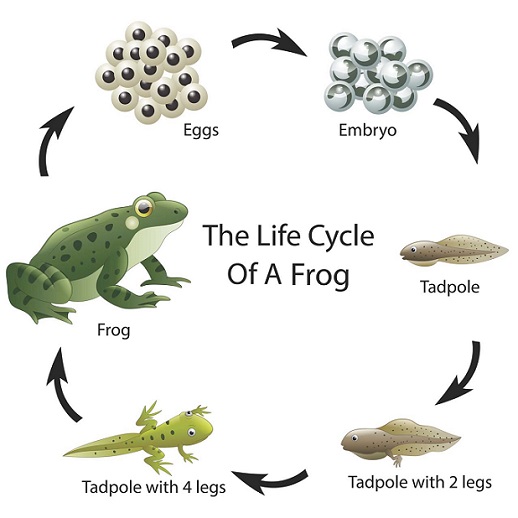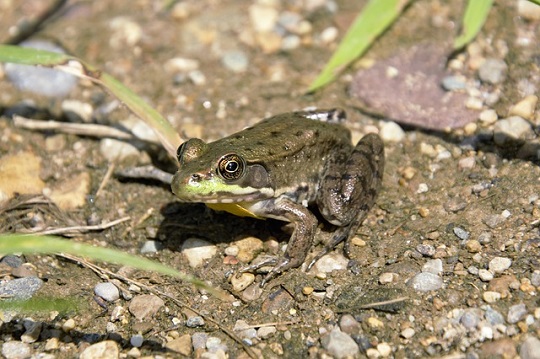The frog is called an amphibian as it can live on both water and land.
Even its growth from egg to adult follows this pattern of translocation.
The mother frog lays its eggs in the water, and the young frogs born out of eggs move on to the land.
Below we will discuss how the entire process happens.
The life cycle of a frog occurs in three stages
- Egg
- Tadpole (larva)
- Adult frog

Before we go into exact details, we will see a brief background.
The development of a tadpole into an adult frog is called metamorphosis.
In this process, the young larva of the frog changes into an adult.
To lay eggs, the female frog should mate in the breeding season to ensure the fertilization of eggs by sperm.
Frogs’ breeding season usually occurs during spring in a temperate climate and rainy season in tropical climates.

When the male frog is ready to couple, it calls upon its female mate by a loud croaking sound.
Male frogs are often heard making such sounds in the rainy season, which creates a ‘chirp’ -sound.
During mating, the male frog holds onto the back of the female frog by clasping its front legs around her waist or neck. This kind of hold or embrace is called ‘amplexus.’ The amplexus position ensures optimal fertilization of eggs with sperms as the female lays it.
Stages of Frog Metamorphosis Diagram
Egg
- This is the first stage of frog life.
- The female lays her eggs in calm waters around the vegetation.
The intention to do so is to protect its eggs from predators. Each female frog lays many eggs that get aggregated into groups called ‘spawn.’

- As the eggs get laid, the male sperm fertilizes them.
- In many species of frogs, it is seen that they do not care about the eggs and leave them to propagate themselves.
- However, in few species like marsupial frogs, Rana clamitans, parental care is seen in which they protect their eggs and nurture the development of their eggs.
- As the development of the eggs starts, the zygote present in the eggs splits into more and more cells and starts developing into a ‘tadpole’- the larva of the frog.
Within one or three weeks, the eggs are ready to hatch, and a tiny tadpole breaks free.
Tadpole
Tadpole constitutes the second stage of the frog life cycle. The morphological characters of a tadpole comprise of
- Rudimentary gills
- a mouth and
- a long tail.

- In the very first week after hatching, the tadpoles show only a small amount of movement.
- They breathe with the help of gills. During this time, the tadpoles sustain by absorbing the remaining yolk from the egg.
- Towards the complete consumption of yolk, the tadpoles become stronger enough to swim in the water.
- They then feed on algae and other vegetation around them. The food is attained by tearing apart the small edible plants.
- In this initial stage, they are herbivores. (see the digestive system of frog)
- As they keep growing, gradually, tadpoles start to develop hind limbs.
- The body gets elongated, and the diet becomes more efficient and healthy.
- Their food preference shift towards the larger plants and even insects.
- With the further course of development, the front limbs grow, the tail starts to disappear, gills get covered by skin, and the cartilage is replaced by bones.
The skull also changes and transforms into an adult-like rather than a larval type.
Frog
- This is the third and final stage of the frog life cycle.
- At approximately around 12 weeks of age, the tadpole body gets fully grown up.
- The tail shrinks, and gills get absorbed into the body. The frog’s external anatomy now has just a head, trunk, and limbs.
- The animal starts to breathe with its lungs. This stage is also called a froglet stage.
Here the tadpole has reached the adult form of its life cycle.

- The fully grownup frog is now ready to move out of the water.
- It starts to live on the land for a significant portion of its life.
- It will also have the ability to live in water and try to repeat the life cycle to sustain its future generation.
- Metamorphosis occurs in most other amphibians, in which they undergo some remarkable, characteristic changes throughout their life cycles.
- Hormones play a vital role in the transformation of eggs into developed animals. Mainly, prolactin and thyroxine control this process in frogs.
